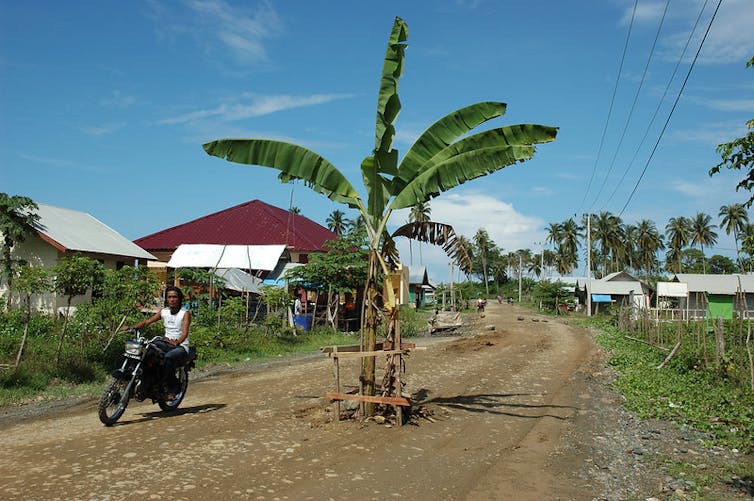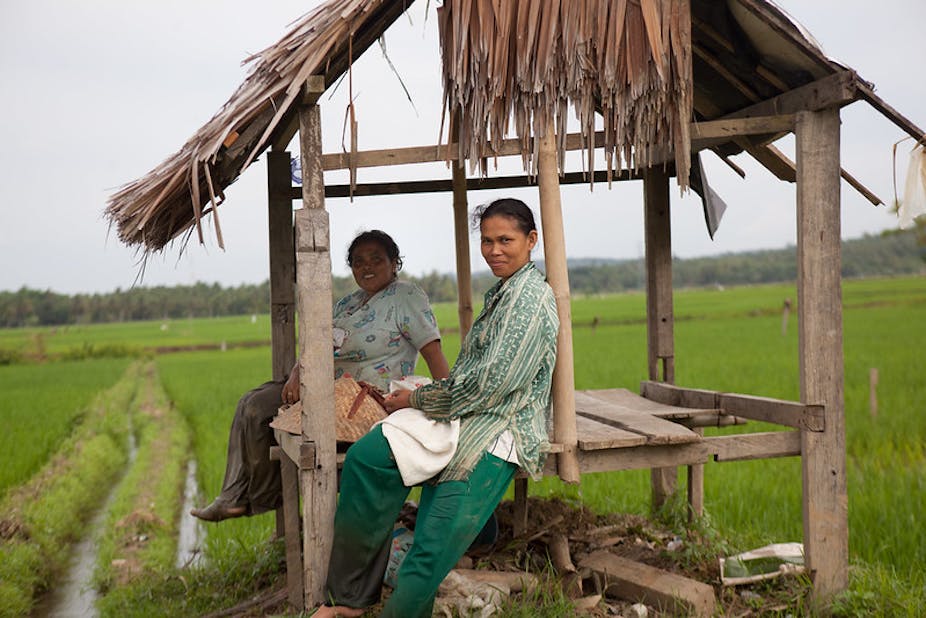Before the COVID-19 pandemic, Indonesia’s poverty rate has fallen to its lowest level ever. In September, statistics suggested there are 24.79 million poor people, equal to 9.22% of the nation’s population.
Despite the improvements, health statistics tell us that around 30.8% of children remain undernourished or stunted.
Indonesian, Australian and Dutch social scientists have been studying the links between livelihoods and stunting, looking at how people get by or even progress between farming, labour markets and social protection.
We wish to understand from a sociological perspective why declining poverty is associated with an inability to access a nutritious meal throughout the year, what we call food poverty.
Our initial research findings examine how this works in lowland Aceh, explaining some of processes connecting food and statistical poverty. It suggests a need for some changes in how we read poverty statistics.
Initial findings
Sociologists describe the situation where poor rural people neither find secure livelihoods through work in the labour market nor through farming as a “truncated transition”.
This suggests a kind of stagnation where rural people are unable to transition from the village to secure paid labour in the city.
Rural Aceh is one of the areas on the economic periphery, marginal to Indonesia’s industrial centres.
Although poverty rates prior to COVID-19 had fallen in Aceh to 15%, this is the poorest province on the island of Sumatra.
Lowland Aceh produces a large rice surplus and half the population works in agriculture. However, it also has food poverty and high stunting. In 2015, Aceh Besar and Aceh Utara had stunting rates of around 30% and 43% respectively.
Yet the Acehnese rarely go hungry: they eat large plates of rice while many cut back on fish and other protein, especially during the scarcity season or (known as paceklik).
Many poor people are tenant farmers. Once they pay debts, land rent and for farming inputs, they are unable to store enough rice to make it until the next harvest. Thus they face periods of scarcity before the harvest.
Those finding ways out of poverty are diversifying their incomes enough to escape this scarcity season.
Yet, most villagers have limited chances to obtain enough work outside agriculture. If they leave Aceh, most access low-wage, unskilled, precarious work.
Surveys in two villages in Aceh Besar and Aceh Utara revealed that of those obtaining more than 40% of income off-farm, 37% cut back on food during the scarcity period. Food security surveys revealed that 35% and 42% of villagers in each case cut back on fish (the main source of protein) in the scarcity season, including 60% of the poor.

Basic needs have changed
Nowadays even poor households need a motorbike and a mobile phone, and money to pay for school needs, or to fix their house.
As families buy so many products, high expenses affect nutritional security. People make wicked choices between buying fish or paying school fees, fixing their roof or buying livestock.
We can understand stunting in terms of how large numbers of people move sideways. So many households get by, and improve their houses and accrue assets, even while they cut back on protein.
The Social Affairs Agency uses poverty-measuring technologies to calculate the welfare of a household and to allocate benefits under the Conditional Cash Transfer (Program Keluarga Harapan, or PKH) and Food Assistance (Rastra/BPNT) programs. Here a household’s assets are used as an indicator of their wealth. However, if households have made gradual improvements even while they cut back on protein, they may be judged as non-poor even while they remain food poor.
Hence, food poverty may be overlooked by poverty statistics and by the poverty-targeting technologies used to allocate social cash transfers.
The implications of this study are many.
Statistical analysis needs to be complemented by qualitative studies showing why food poverty persists and to think through how statistics might better capture food poverty.
Cash transfers are an important way to reach the poor and the program’s reach is expanding, but many food poor households remain outside the social security net. Complementary social assistance programs could also be rolled out during the scarcity season when people are most vulnerable.
Reforms might aim to help farmers obtain credit, better prices and cheaper inputs. Policymakers can recognise the structural drivers of poverty, how growth might be more inclusive and how labour markets might work better for the poor. Such issues may be difficult to understand from poverty statistics and may not be easily resolved by cash transfers.
Moving beyond estimates of poverty based on the capacity to purchase the minimum amount of calories and most basic non-food needs, or using a survey of household assets to estimate incomes to target assistance, our understanding of poverty can be adjusted to include local practices and changing social needs.

